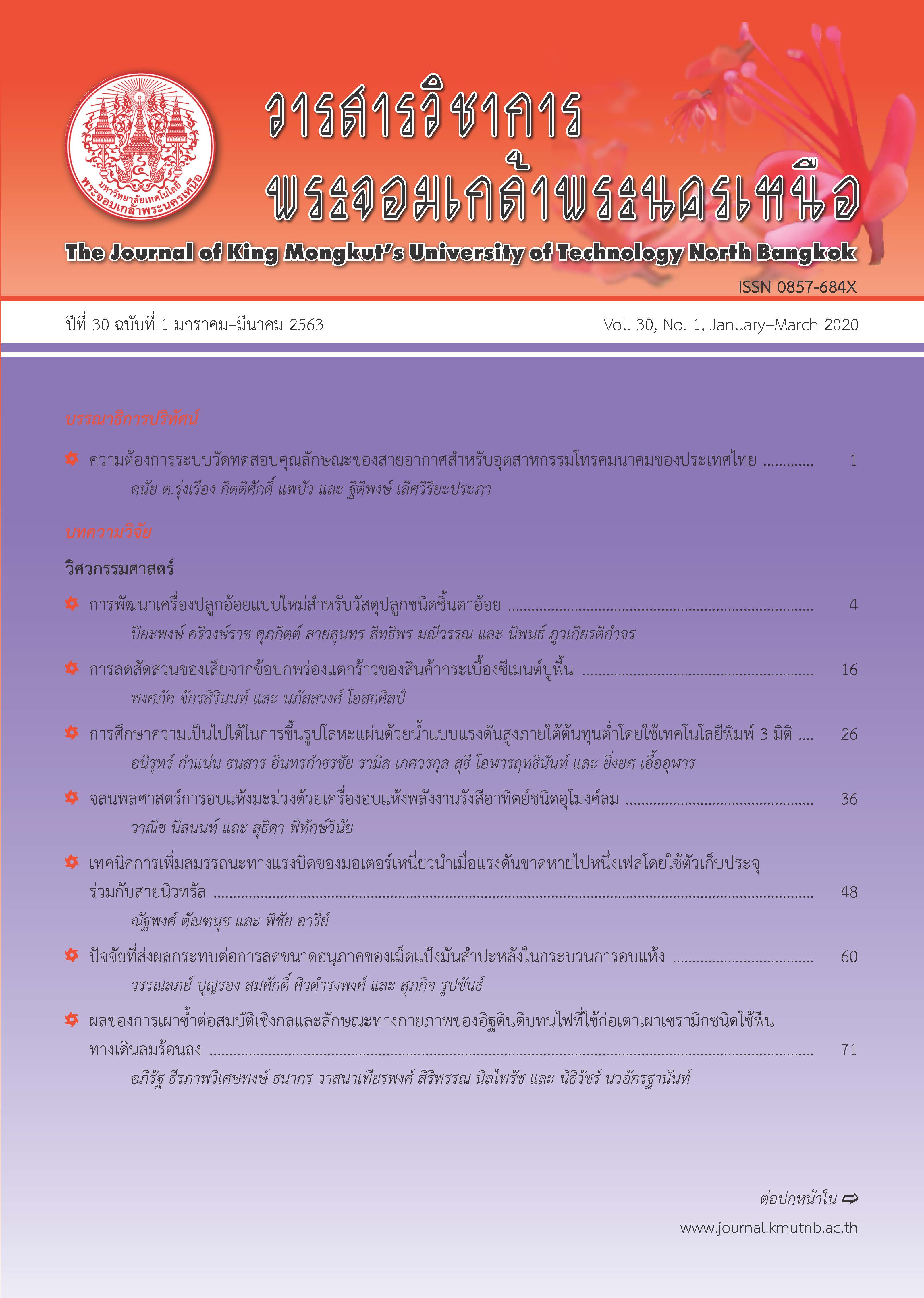การประยุกต์ใช้วิธีเชิงพันธุกรรมเพื่อหาค่าใช้จ่ายรวมต่ำที่สุดสำหรับแผนการชักตัวอย่างเพื่อการยอมรับแบบสองชุด
Main Article Content
บทคัดย่อ
แผนการชักตัวอย่างเพื่อการยอมรับรุ่นแบบสองชุดภายใต้ความเสี่ยงของผู้ผลิตและผู้บริโภคเป็นเครื่องมือสำคัญในการกำหนดแผนการตรวจสอบผลิตภัณฑ์ที่เหมาะสม ซึ่งในสถานการณ์จริงผู้ใช้งานอาจไม่ทราบถึงค่าความเสี่ยงของผู้ผลิตและผู้บริโภคที่แท้จริง เพียงแต่ทราบสัดส่วนเสียในรุ่นการผลิต งานวิจัยนี้จึงมีวัตถุประสงค์เพื่อเพิ่มประสิทธิภาพในการเลือกแผนการชักตัวอย่างเพื่อการยอมรับแบบสองชุดที่เหมาะสมภายใต้แนวคิดที่ทราบเพียงค่าสัดส่วนเสียในรุ่นการผลิต และต้องการให้เกิดค่าใช้จ่ายรวมในการตรวจสอบ (TC) ต่ำที่สุด โดยประยุกต์ใช้วิธีทางพันธุกรรมช่วยคำนวณหาค่าที่เหมาะสมของขนาดตัวอย่าง (n1, n2) และจำนวนของเสียมากสุดที่ยอมรับได้ (c1, c2) ผลการศึกษาพบว่าเงื่อนไข n1 = n2 และ c1 ≤ c2 – 1 ส่งผลให้ค่าใช้จ่ายรวมต่ำที่สุด ส่วนเงื่อนไข n1 = 2n2 และ c1 ≤ c2 – 1 จะส่งผลให้ค่าจำนวนของเสียที่ตรวจพบมากที่สุด นอกจากนี้พบว่าเมื่อขนาดตัวอย่างเพิ่มมากขึ้นจะส่งผลให้ค่าใช้จ่ายรวมในการตรวจสอบ (TC) จำนวนของเสียที่ตรวจพบ (Nd) และจำนวนตัวอย่างที่นำมาตรวจสอบเฉลี่ย (ATI) จะเพิ่มขึ้นด้วย ในขณะที่ความน่าจะเป็นที่จะยอมรับรุ่น (Pa) และคุณภาพผ่านออก (AOQ) มีค่าลดลงตามลำดับ
Article Details
บทความที่ลงตีพิมพ์เป็นข้อคิดเห็นของผู้เขียนเท่านั้น
ผู้เขียนจะต้องเป็นผู้รับผิดชอบต่อผลทางกฎหมายใดๆ ที่อาจเกิดขึ้นจากบทความนั้น
เอกสารอ้างอิง
[2] B. P. M. Duarte and P. M. Saraiva, “An optimizationbased approach for designing attribute acceptance sampling plans,” International Journal of Quality & Reliability Management, vol. 25, no. 8, pp. 824–841, 2008.
[3] I. Kaya, “A genetic algorithm approach to determine the sample size for attribute control charts,” Information Sciences, vol. 179, no. 10, pp. 1552–1566, 2009.
[4] A. Kobilinsky and Y. Bertheau, “Minimum cost acceptance sampling plans for grain control, with application to GMO detection,” Chemometrics and Intelligent Laboratory Systems, vol. 75, no. 2, pp. 189–200, 2005.
[5] T. M. Cheng and Y. L. Chen, “A GA meachanism for optimizeng the desing of attribute-doublesampling-plan,” Automation in Construction, vol.16, no.3, pp.345–353, 2007.
[6] S. Sampath and S. P. Deepa, “Determination of optimal double sampling plan using genetic algorithm,” Pakistan Journal of Statistics & Operation Research, vol. 8, no.2, pp. 195–203, 2012.
[7] L. F. Hsu and J. T. Hsu, “Economic design of acceptance sampling plans in a Two-Stage supply chain,” Advances in Decision Sciences, vol. 2012, Article ID 359082, pp. 1–14, 2012.
[8] O. J. Braimah, Y. K Saheed, R. O. Owonipa, and I. O. Adegbite, “Economic reliability acceptance sampling plan design with zero acceptance, ” African Journal of Computing & ICT, vol. 8, no. 3, pp. 69–84, 2015.
[9 A. Khadwilard, “Application of genetic algorithm for optimisation problems,” RMUTP Research Journal, vol. 5, no. 2, pp.153–163, 2011 (in Thai).

